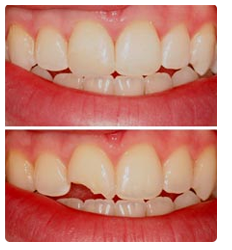Tooth Bonding
 Repairs minor imperfections
Repairs minor imperfections
If you have a slight imperfection in your teeth, bonding can be a simple way to improve your smile. Bonding can repair teeth that are:
- Stained
- Chipped
- Crooked
- Have Minor gaps
And in some cases, bonding can repair a cavity with a natural-looking, tooth-colored restoration.
Advantages of bonding
- Bonding can be a quick procedure, often done in just an hour or two.
- Many bonding procedures can be performed without anesthesia.
- It can be less expensive than a crown or veneer.
Procedure
To prepare a tooth for bonding, we clean off any plaque and tartar. We choose a shade that matches your natural tooth color. The tooth needs to be dry, so we may use a rubber dam to isolate it.
To begin, we use a mild etching solution to condition the tooth surface. This helps the bonding agent adhere to your tooth.
We then apply the bonding material and harden it with a special curing light.
We add another layer of resin, and again, harden it with the curing light. We may do this several times until we reach the proper thickness. Once all layers have been placed, we sculpt them to the desired shape.
We check your bite to make sure your tooth functions properly.
Finally, we polish your tooth to a smooth and beautiful finish. With proper care, the bonding material should last between 3 and 10 years.
Bonding can be a good way to repair minor problems and give you a beautiful smile.
